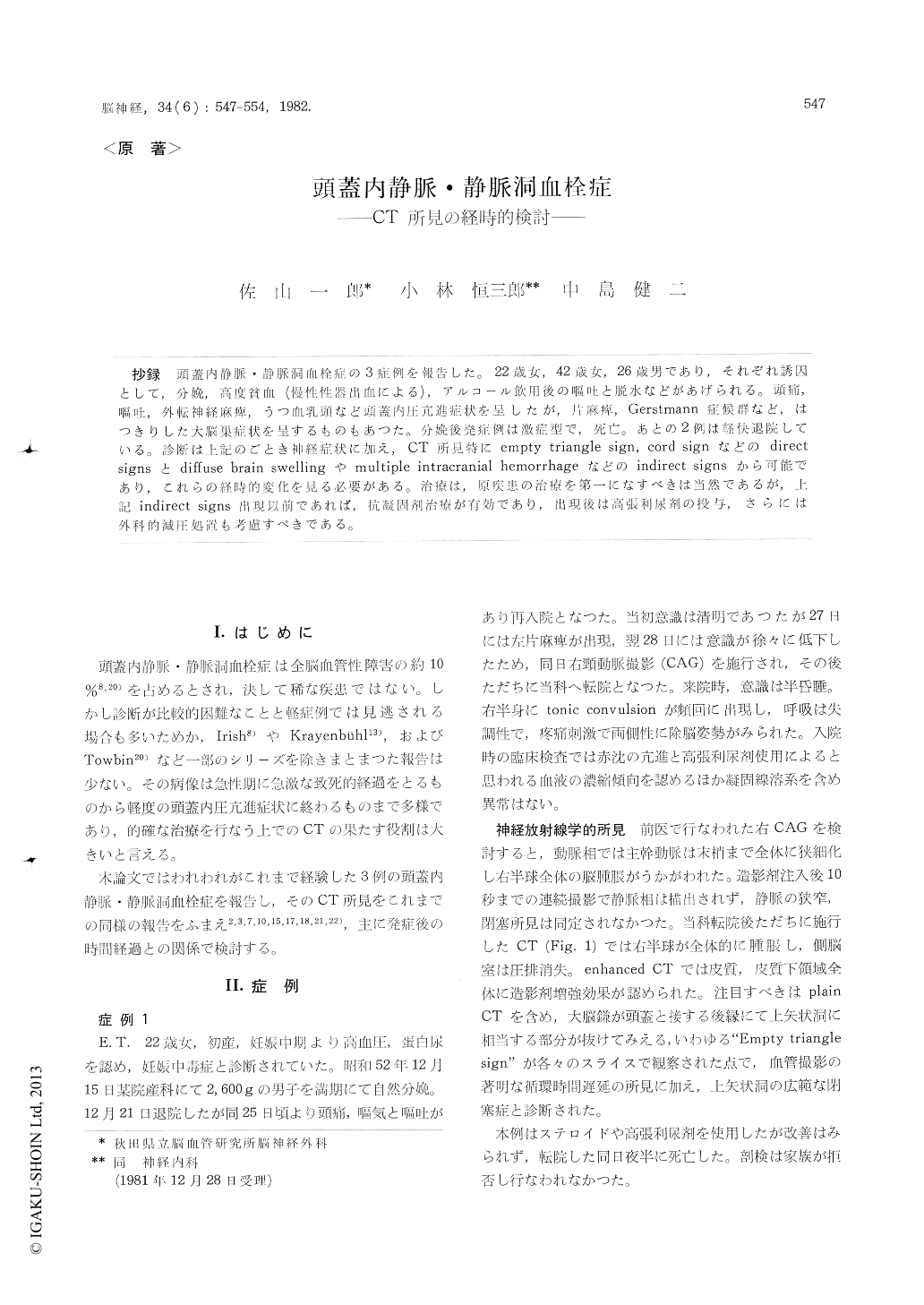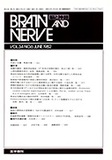Japanese
English
- 有料閲覧
- Abstract 文献概要
- 1ページ目 Look Inside
抄録 頭蓋内静脈・静脈洞血栓症の3症例を報告した。22歳女,42歳女,26歳男であり,それぞれ誘因として,分娩,高度貧血(慢性性器出血による),アルコール飲用後の嘔吐と脱水などがあげられる。頭痛,嘔吐,外転神経麻痺,うつ血乳頭など頭蓋内圧亢進症状を呈したが,片麻痺,Gerstmann症候群など,はつきりした大脳巣症状を呈するものもあつた。分娩後発症例は激症型で,死亡。あとの2例は軽快退院している。診断は上記のごとき神経症状に加え,CT所見特にempty triangle sign,cord signなどの directsignsとdiffuse brain swellingやmultiple intracranial hemorrhageなどのindirect signsから可能であり,これらの経時的変化を見る必要がある。治療は,原疾患の治療を第一になすべきは当然であるが,上記indirect signs出現以前であれば,抗凝固剤治療が有効であり,出現後は高張利尿剤の投与,さらには外科的減圧処置も考慮すべきである。
Three cases of cerebral sino-venous thrombosis are reported. Repeated CT findings were studied and discussed on account of the treatments for those pathologic conditions. Those of studied cases are ; a 22-year-old postpartum woman, a 42-year-old woman with irregular vaginal bleeding, and a 26-year-old man with severe reactive emesis after drinking alcohol.
The patho-etiology of these cases were non-in-fections, and were classified as the primary type. The results of laboratory examinations including fibrinolytic activities were almost normal except for the acceleration of blood sedimentation rates in Case 1 and 2.
Clinical courses were various. Such an aggres-sive and fetal course had elapsed in Case 1, some focal neurological signs and symptoms were ap-peared in Case 2, and the last one presented double vision and bilateral choked discs due to intracranial hypertension without any focal neurological deficits. They were treated conservatively. Case 1 died in its acute stage. In the remaining ones, each hadan uneventful recovery.
All of their angiographic studies were profitable to their exact diagnoses and to evaluate their pathologic conditions. In Case 1, marked brain swelling and resultant delay of circulation time of cerebral blood flow made it impossible to get an visualization of venous phases in its serial right carotid angiograms. In Case 2, thrombotic steno-occlusions had been detected at one-third posterior portion of superior sagittal sinus (SSS) and the neighboring cortical veins, which presented complete recanalization in the follow up angiograms after 8 months. In Case 3, the serial carotid angiograms had revealed complete SSS occlusion at its mid-portion without any detectable abnormalities in the arterial phases. The venous collaterals, however, were well-developed, and follow up angiograms after one month later showed the same findings as far as the SSS occlusion. CT scan findings of them manifested their exact clinical conditions at that point. These findings were devided into two categories, one was direct signs expressed sino-venous occlusion, the other was indirect signs which appeared as a result of these occlusion. One of the direct signs called "Empty triangle sign" which coined by Bounanno et al. in enhanced CT photoes were detected not only in enhanced films, but also in plain ones in Case 1 and 3. The initial CT study in Case 2 showed no particular findings, but one week later, follow-up CT indicated venous hemorrhagic infarction in left parietooccipital junc-tional area, which became localized in further follow-up study. Direct signs cannot always get in every cases with sino-venous occlusion, but as for indirect signs, we can get various changes cor-responding to the time taken CT photoes, and they are useful to decide appropriate treatments at that time. When we can not detect hemorrhagic in-farction or intracerebral hemorrhage by CT scans yet, fibrinolytic therapy should be first indicated. When it becomes accompanied by intracranial hypertension, some dehydrative agents and steroids should be chosen. Unless these conservative treatments are sufficient, surgical interventions, such as ventricular drainage, external decompression may be necessary.
Considering suitable treatments for this disease, it is necessary to select most suitable ones according to their pathologic conditions, which may be precise-ly drawn with CT scans.

Copyright © 1982, Igaku-Shoin Ltd. All rights reserved.


